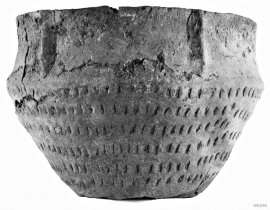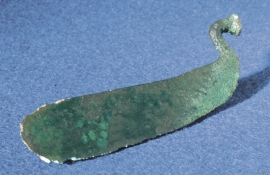Published: 15.01.2013 | Author: Svein Indrelid
Hystadmarka is a rich area of cultural heritage. (Jan Rabben).
For us it seems that the mounds in Hystadmarka are very inaccessible, hidden as they are in the forest and overgrown by heath and brushwood. But at the time they were built as memorials to the dead, the sea level was around 2 meters higher than it is today. The boggy area between Valevågen and Mjelkevika was then a sound with islets outside. The mounds were situated on both sides of the sound, quite visible for seafarers going past in a boat.
Some of the mounds have been damaged by robberies or other disturbance. The finds are rather few, for in the wet west Norwegian weather little is preserved of burial goods in such porous mounds.
Some of the mounds in Hystadmarka have been used for burial several times over. In one of them as many as five stone sarcophagi from the Bronze Age have been found (see drawing). Two thousand years later Hystadmarka was again a burial place, as a graveyard for cholera victims.
Hystadmarka
Map over Hystadmarka with the recreation area. (after Høyland, O. (1966-1973) Stord bygdebok. Bd I, s. 94, og teknisk etat).
Gravfunn
In a mound on the west side of Valevågen (now removed), there were five graves. The sarcophagus of human length at the centre is probably from early Bronze Age (1500-1000) years BC, and is circled by a finely built wall (B). Outside the wall there are four small stone sarcophagi from early Bronze Age (C) 1000-500 years BC). T (after Bakka, E. i Høyland, O. (1966-1973) Stord bygdebok. Bd I, s. 100).
Kolerakyrkjegarden i Hystadmarka
A grave monument on the cholera churchyard in Hystadmarka. (Jan Rabben).
Burial urns
The urns from the stone sarcophagi in a mound in Hystadmarka are decorated with rows of prints from a fingernail, and can be dated to the late Bronze Age. They contain burned human bones. In a sarcophagus in another mound there was a bronze shaving knife, together with scraps of birch bark and burned bones. Shaving knives are common grave gifts in southern Scandinavian Bronze Age, but there are not many in our country. Together with tweezers and a needle or an awl, they belonged to a man’s toiletries. The shaving knife from Hystadmarka is from first part of the early Bronze Age, almost 1000 years BC.








